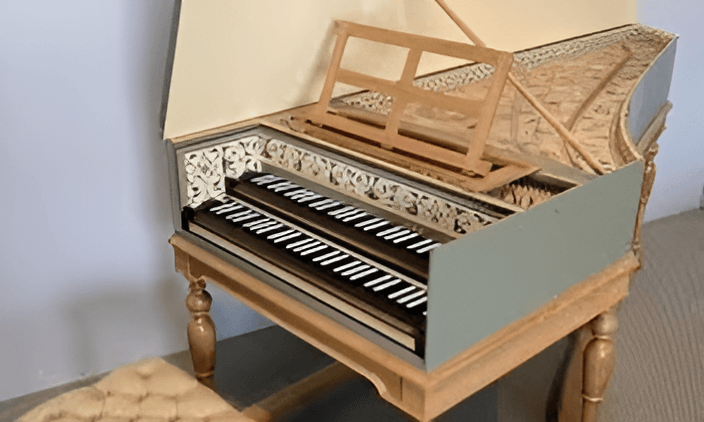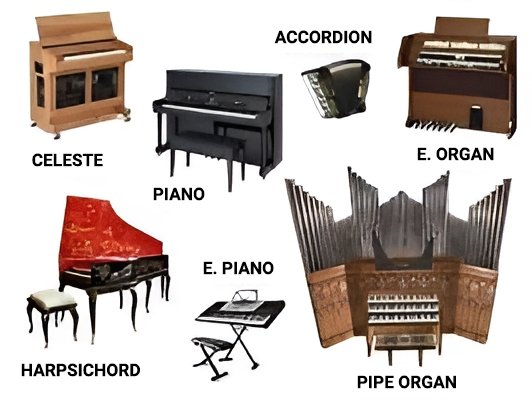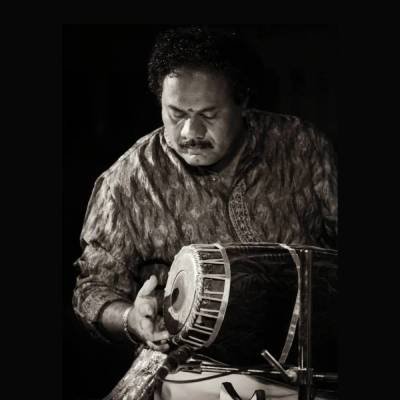History and Origin of Keyed Instruments
Throughout history and time, music has been a key essence/ driving factor in human civilisation acting as that spark of life, and has gone continuous transformation and evolution owing to people’s striving efforts to create new and innovate instruments to express their artistic endeavours. One such category of instrument that had captivated generations with its enchanting melodies and versatility is the origin of keyed instruments. From the ancient Hydraulis to the Classical pianos to modern day electric piano and keyboards/ synthesisers the journey of evolution of these fascinating instruments have been nothing less than spectacular.
This rich history and heritage has been a key factor in the rise of learning to play keyboard, rise of personal and online lessons for keyboard and other keyed instruments like Harmonium, piano etc.
Ancient Beginnings:
The origins of the keyboard like instruments can be traced to ancient times, specifically to the Hydraulis, an ancient Greek instrument, invented in the 3rd century BCE by Ctesibius of Alexandria. The Hydraulis utilised a complex system of water pressure to create sounds. The keys when pressed opened valves that released compressed air into pipes, thereby producing different notes. The Hydraulis was an early precursor to the modern keyboard, piano, harmonium etc.
The Emergence of Pipe Organ:
During the medieval the hydraulics evolved into pipe organ, which emerged as one of the most significant keyboard instruments. Pipe organs were colossal structures , found in churches and cathedrals. Upon activation of each key, intricate mechanisms allowed air to flow into massive pipes, of varying lengths, producing different pitches.

The Birth of Harpsichord:

As the Renaissance era gave way to the Baroque period, a new keyboard instrument made its debut, The Harpsichord, developed in the 14th Century- distinguished itself from the pipe organ by employing plucked strings. The Harpsichord had a mechanism where pressing keys caused a quill or plectrum to pluck the corresponding string.
The revolutionary Piano:
18th Century witnessed a ground breaking innovation in keyboard instrument – the piano (which would revolutionise music as we knew it). Invented by Bartolomeo Cristofori in Italy around 1700, the piano or Pianoforte utilised a unique hammer mechanism that struck corresponding strings when a key was pressed.
Keyboard as an instrument in modern Era:
With the advent of industrial revolution and advancement in technologies, the 19th and 20th centuries witnessed a myriad of developments in keyboard instruments. The invention of electric organ in the mid 20th century followed by electronic synthesiser and digital piano brought forth new possibilities for sound manipulation and experimentation.
Rise and distinction between keyboard- piano- harmonium- and other keyed reed instruments
| Feature | Piano | Keyboard | Harmonium | Other Keyed Reed Instruments (Accordion, Melodica, etc.) |
|---|---|---|---|---|
| Definition | Acoustic instrument with strings struck by hammers. | Electronic or digital instrument that produces sound via speakers or amplification. | A free-reed instrument where air is pumped through reeds to produce sound. | Instruments like the accordion use a free-reed mechanism, with sound produced by air passing over reeds controlled by keys and bellows. |
| History | Invented by Bartolomeo Cristofori in 1700, evolved from harpsichord and clavichord. | Emerged in the 20th century with electronic advances. | Originated in Europe in the 19th century, brought to India by missionaries. | The accordion developed in early 19th-century Europe, evolving from earlier bellows-operated reed instruments. |
| Sound Production | Hammers strike strings to produce sound. | Sound is generated electronically or digitally, simulating different instruments. | Air is pumped through reeds by bellows, producing sound when keys are pressed. | Air is pumped through reeds via bellows; keys control airflow over reeds, producing sound. |
| Types | Grand, upright, baby grand, concert grand. | Synthesizers, digital pianos, workstations, MIDI controllers. | Portable, tabletop harmoniums, foot-pumped models (rare). | Accordions (button or piano accordion), concertinas, bandoneons. |
| Size and Portability | Large and heavy, not portable. | Lightweight and portable; some models are compact. | Relatively small and portable, often used in folk or devotional music. | Generally portable, though larger accordions can be heavy. |
| Touch Sensitivity | Weighted keys with full dynamic control (responds to pressure). | Varies: can be unweighted or semi-weighted; touch-sensitive on higher-end models. | Not touch-sensitive; volume and dynamics depend on how air is pumped through the bellows. | Accordion buttons or keys do not respond to touch sensitivity; volume is controlled by the bellows. |
| Maintenance | Requires regular tuning and maintenance of strings, hammers, and soundboard. | No tuning needed; minimal maintenance. | Requires maintenance for reeds and bellows; occasional tuning. | Reeds and bellows need maintenance and occasional tuning, especially for air leaks. |
| Cost | Expensive, particularly grand pianos. | Wide price range, from affordable beginner models to high-end. | Affordable compared to pianos, though professional models can be costly. | Varies depending on quality and size; professional accordions can be expensive. |
| Sound Variety | Limited to acoustic piano sounds. | Can mimic a wide range of instruments and tones, programmable. | Limited to harmonium sound; some models have multiple reed banks for slight tonal variation. | Limited to accordion or concertina sound, though some have switchable reed banks for tonal variety. |
| Amplification | Natural acoustic amplification. | Requires external amplification or built-in speakers. | No electronic amplification; relies on natural sound projection. | No electronic amplification, though some models have built-in mics for amplification in performances. |
| Pedals | Three pedals: soft, sostenuto, sustain. | Typically one sustain pedal; more pedals on higher-end models. | No pedals; sound and volume are controlled manually via bellows. | No pedals; sound controlled by bellows and key presses. |
| Primary Usage | Classical, jazz, traditional acoustic performances. | Used in various genres: pop, rock, electronic, orchestral, recording. | Primarily used in Indian, folk, and devotional music, especially in India. | Widely used in folk, traditional music, and tango (bandoneon), as well as popular in genres like polka. |
| Learning Curve | Requires physical effort and skill to master dynamics. | Easier for beginners due to lighter keys and digital aids. | Simple in terms of note production, but nuanced in bellows control. | Similar to harmonium, but with added complexity due to bellows and multiple reed banks. |
| Performance Dynamics | Wide dynamic range based on player’s control of touch and pedals. | Dynamic control varies based on model (unweighted vs. weighted keys). | Volume and expression controlled by pumping the bellows. | Volume and expression controlled by air pressure from the bellows. |
| Notable Players | Classical musicians (Chopin, Beethoven, Liszt). | Contemporary musicians, electronic artists (Stevie Wonder, Herbie Hancock). | Preferred musical instrument for folk, Carnatic, hindustani artists for regional performances. (Purushottam Walawalakar). Notable Bmusician faculty who was a reputed Carnatic Harmonium artist - Shri Palladam Venkataramana Rao. | Accordion virtuosos like Astor Piazzolla (bandoneon), folk musicians. |
Different types of Keyboards, Pianos, Harmoniums and other keyed instruments:
| Instrument Category | Type |
|---|---|
| Piano | Grand piano, Upright Piano, Baby Grand piano, Digital piano |
| Keyboard | Synthesizer, Workstation, Arranger keyboard, MIDI controller |
| Harmonium | Portable harmonium, Standard harmonium (single reed/double reed), Foot-pumped harmonium |
| Other Reed-Keyed Instruments | Piano accordion, Button accordion, Concertina, Bandoneon |
Final Inference:
The world of keyed instruments is vast and diverse, ranging from the classical elegance of the piano to the portable versatility of modern keyboards and harmoniums. Pianos include grand, upright, and baby grand variations, each offering different sizes and sound projection, while digital pianos bring modern technology into the fold with their ease of use and sound replication. In the realm of keyboards, synthesizers, MIDI controllers, and workstations provide a wide range of sounds and functionalities for genres like pop, electronic, and orchestral music. Meanwhile, harmoniums, popular in Indian classical and devotional music, are categorized into portable, standard, and foot-pumped types, each serving specific needs for performance and practice. Other keyed reed instruments, such as the accordion, concertina, and bandoneon, utilize free reeds and bellows to produce unique sounds often associated with folk, tango, and traditional music.
Together, these instruments demonstrate the diversity of musical expression available through keys, whether acoustically, electronically, or through reed-based sound production. With improvement and accessibility, a lot of scope for learning these instruments have come up in recent past in form of Online piano lessons, Online Harmonium lessons, Online keyboard lessons etc.






















